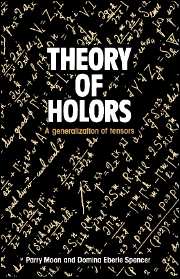Preface
Published online by Cambridge University Press: 16 October 2009
Summary
The word holor indicates a mathematical entity that is made up of one or more independent quantities. Examples of holors are complex numbers, vectors, matrices, tensors, and other hypernumbers. The very fruitful idea of representing a collection of quantities by a single symbol apparently originated in 1673, when John Wallis represented a complex number as a point in 2-space. More complicated holors were developed by Hamilton (1843), Grassmann (1844), Gibbs (1881), Ricci (1884), Heaviside (1892), Levi-Civita (1901), Einstein (1916), and many others.
An unfortunate aspect of the subject is that each kind of holor was developed more or less independently, with its own nomenclature, its own theory, and its own textbooks. On the contrary, we propose to use a single notation that applies to all holors, be they tensors or nontensors. This step results in an immense simplification. Special symbols and notations, such as boldface type, ∇, grad, div, curl, are abandoned. Ordinary type is used, but with subscripts and superscripts. Such index notation is, of course, common in tensor theory but has not ordinarily supplanted the old notation of vector analysis and matrix theory. The first feature of our book, therefore, is the use of index notation throughout.
A second feature deals with coordinate transformation. A tensor is a holor that transforms in a particularly simple way. But many holors are not tensors.
- Type
- Chapter
- Information
- Theory of HolorsA Generalization of Tensors, pp. xiii - xivPublisher: Cambridge University PressPrint publication year: 1986



